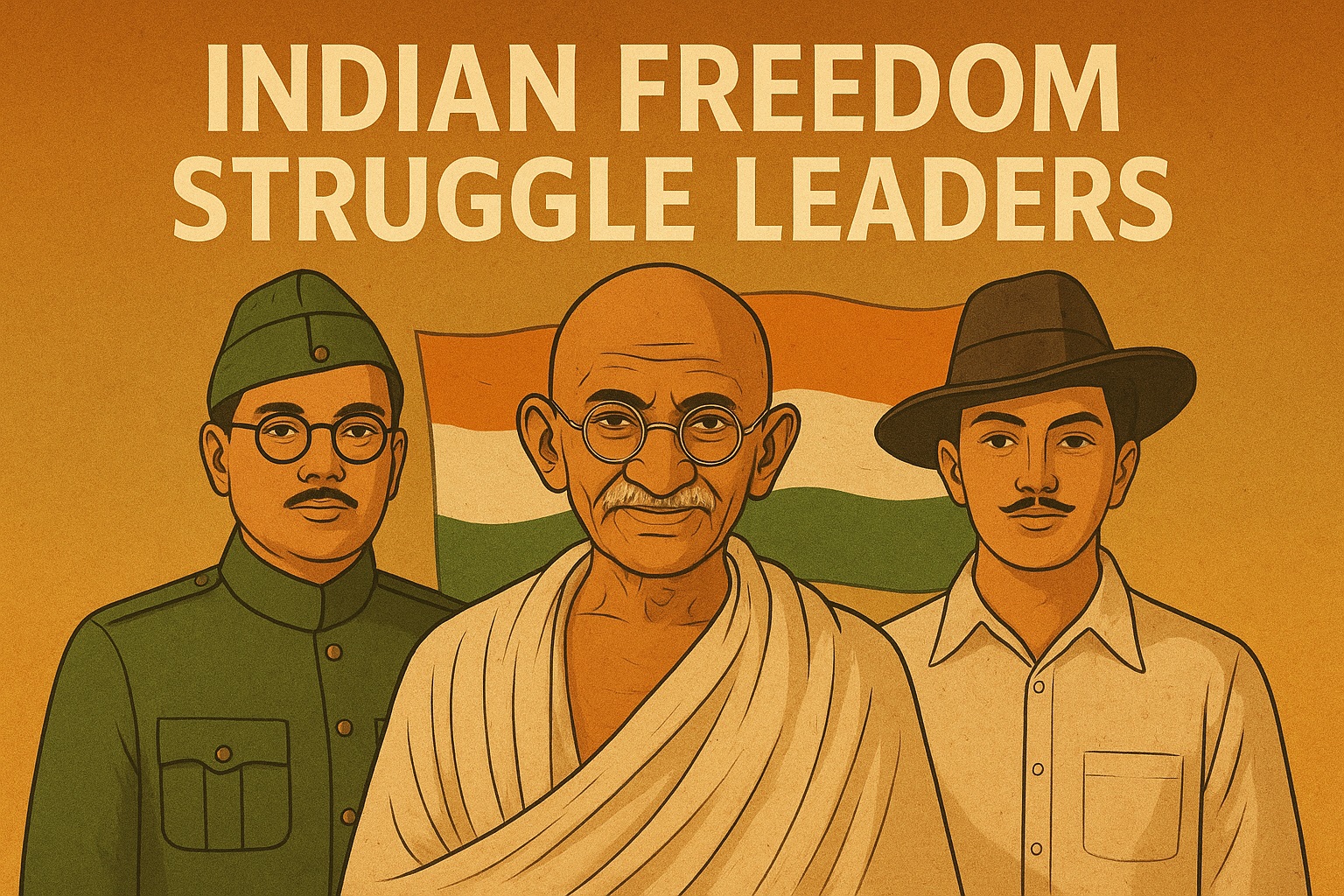Indian Freedom Struggle Leaders-Explore the inspiring journey of India’s freedom fighters – Mahatma Gandhi, Subhas Chandra Bose, and Bhagat Singh. Learn about their struggle, vision, and sacrifices.
For authentic records, visit: National Archives of India
Introduction
The Indian freedom struggle was one of the most inspiring movements in world history. From the late 19th century to 1947, millions of Indians united against British colonialism. Among countless leaders, three iconic personalities stand out — Mahatma Gandhi, Subhas Chandra Bose, and Bhagat Singh. Each of them had a unique ideology and approach, yet their goal was the same: Swaraj, or complete independence.
This article explores their contributions, ideologies, achievements, and legacy in shaping modern India.
Mahatma Gandhi: The Apostle of Non-Violence-Indian Freedom Struggle Leaders
Early Life
- Born on 2nd October 1869 in Porbandar, Gujarat.
- Studied law in London, later moved to South Africa where he faced racial discrimination, inspiring him to fight against injustice.
Philosophy of Non-Violence (Ahimsa)
- Gandhi believed in truth (Satya) and non-violence (Ahimsa).
- He introduced Satyagraha – peaceful resistance against oppression.
- His approach emphasized moral courage over physical strength.
Major Movements Led by Gandhi
- Champaran and Kheda Satyagraha (1917–1918) – peasants’ rights.
- Non-Cooperation Movement (1920–1922) – boycott of British goods.
- Civil Disobedience Movement (1930) – Dandi March against salt tax.
- Quit India Movement (1942) – demand for complete independence.
Legacy
Gandhi became the global face of peaceful resistance, influencing leaders like Martin Luther King Jr. and Nelson Mandela.
Subhas Chandra Bose: The Man Who Defied the Empire-Indian Freedom Struggle Leaders
Early Life and Career
- Born on 23rd January 1897 in Cuttack, Odisha.
- Brilliant student, passed ICS exam but resigned, as he wanted to fight for India’s independence.
Radical Nationalism
- Believed independence could not be achieved through non-violence alone.
- Advocated armed struggle against the British.
Role in Indian National Congress
- Twice elected as President of the Indian National Congress.
- Resigned due to ideological differences with Gandhi and Nehru.
Formation of INA (Indian National Army)
- Escaped from India during WWII.
- Formed the Azad Hind Fauj (INA) with Japanese support.
- Gave the famous slogan: “Give me blood, and I shall give you freedom.”
Legacy
Although Bose did not live to see independence, his courage inspired millions. INA’s struggle weakened the loyalty of Indian soldiers in the British Army.
Bhagat Singh: The Revolutionary Martyr-Indian Freedom Struggle Leaders
Early Life
- Born on 28th September 1907 in Banga, Punjab.
- Influenced by Jallianwala Bagh massacre and execution of Kartar Singh Sarabha.
Revolutionary Activities
- Joined Hindustan Socialist Republican Association (HSRA).
- Advocated socialism and workers’ rights along with independence.
Major Actions
- Lahore Conspiracy Case – planned to avenge Lala Lajpat Rai’s death.
- 1929 Central Assembly Bombing – threw bombs in Delhi Assembly with Batukeshwar Dutt to “make the deaf hear.”
- Execution (1931) – hanged at the age of 23, becoming a martyr for Indian youth.
Legacy
Bhagat Singh became a symbol of courage and sacrifice. His writings on socialism inspired generations.
Contrasting Ideologies: Gandhi vs Bose vs Bhagat Singh-Indian Freedom Struggle Leaders
| Leader | Approach | Key Belief | Legacy |
|---|---|---|---|
| Gandhi | Non-violence, Satyagraha | Moral force > Physical force | Peaceful resistance worldwide |
| Subhas Bose | Armed struggle, INA | Independence through military power | Nationalist hero, “Netaji” |
| Bhagat Singh | Revolutionary socialism | Sacrifice and socialist ideals | Youth icon, martyrdom |
Impact on India’s Independence-Indian Freedom Struggle Leaders
- Gandhi united masses through peaceful protests.
- Bose created international pressure on Britain.
- Bhagat Singh inspired youth and shook British confidence.
Together, they formed a triangular force that made British rule unsustainable.
Global Influence of Indian Freedom Struggle
- Gandhi’s ideas influenced movements in the USA, South Africa, and beyond.
- Bose inspired Asian independence movements.
- Bhagat Singh became a symbol for anti-colonial youth worldwide.
Conclusion
Indian Freedom Struggle Leaders-The freedom struggle of India was not the achievement of one ideology but a combination of multiple approaches. Gandhi’s non-violence, Bose’s armed resistance, and Bhagat Singh’s revolutionary sacrifice complemented each other. Their collective vision continues to inspire India’s democracy, unity, and social justice even today.
India’s independence in 1947 was the result of sacrifices, leadership, and determination of countless people — but Gandhi, Bose, and Bhagat Singh remain eternal icons of courage and patriotism.

